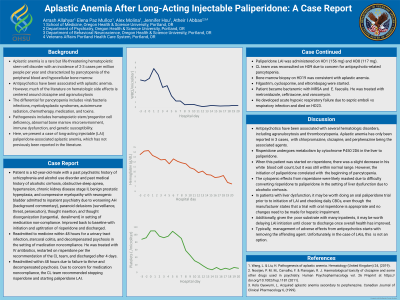Psychopharmacology and Toxicology
Session: Poster Session
(133) Aplastic Anemia After Long-Acting Injectable Paliperidone: A Case Report

Trainee Involvement: Yes

Arrash Allahyar, MD
Resident physician
Oregon Health & Science University, United States
Elena Paz Munoz, BS
Medical Student
Oregon Health and Science University
Portland, Oregon, United States- AM
Alejandro Molina, MD
Resident Physician
Oregon health and Sciences University
Portland, Oregon, United States 
Jennifer Hsu, DO
Fellow
Oregon Health & Science University
Portland, Oregon, United States
Atheir Abbas, MD, PhD
Psychiatrist
Oregon Health & Science University
Portland, Oregon, United States
Presenting Author(s)
Co-Author(s)
Background/Significance: Aplastic anemia is a rare but life-threatening hematopoietic stem-cell disorder characterized by pancytopenia of the peripheral blood and hypocellular bone marrow. It has an incidence of 2-3 cases per million each year.1 Antipsychotics have been associated with aplastic anemia. However, much of the literature on hematologic side effects are centered around clozapine and agranulocytosis. Here we present a case of long-acting injectable (LAI) paliperidone-associated aplastic anemia, which has not previously been reported in the literature. References 1. Wang, L. & Liu, H. Pathogenesis of aplastic anemia. Hematology (United Kingdom) 24, (2019). 2. Ziegenbein, M., Steinbrecher, A. & Garlipp, P. Clozapine-induced aplastic anemia in a patient with Parkinson’s disease [7]. Canadian Journal of Psychiatry vol. 48 Preprint at https://doi.org/10.1177/070674370304800519 (2003). 3. Kola Oyewumi, L. Acquired aplastic anemia secondary to perphenazine. Canadian Journal of Clinical Pharmacology 6, (1999).
Case: A 62-year-old male with a past psychiatric history of schizophrenia and alcohol use disorder was admitted to the psychiatric ward due to worsening paranoid delusions and thought disorganization. He had a medical history of cirrhosis, obstructive sleep apnea, hypertension, chronic kidney disease stage 2 and benign prostatic hyperplasia (with a suprapubic catheter). He was discharged on 2 mg risperidone daily. Within the next few weeks, he was admitted twice to the hospital for acute medical concerns. The first admission was for a urinary tract infection (UTI) and colitis, and the second was for persistent UTI and weakness. Consultation-Liaison Psychiatry was consulted upon admission during both hospitalizations due to persistent psychosis. During the first admission, risperidone was increased to 3 mg daily. Because of concern for lack of medication adherence during the latter hospitalization, he was switched from risperidone to LAI paliperidone. He received 156 mg of LAI paliperidone and seven days after that, 117 mg. On hospital day 8, psychiatry was reconsulted due to concern for antipsychotic-related pancytopenia (WBC 0.5, Hct 11.7, Plt 56). Bone marrow biopsy demonstrated aplastic anemia. The patient was started on filgrastim daily. However, the patient became bacteremic with MRSA and E. faecalis. Despite aggressive antimicrobial treatment, the patient’s condition worsened, and he died on hospital day 22.
Discussion: We present a case of a patient who developed fatal aplastic anemia after switching from oral risperidone, which is metabolized to paliperidone, and initiation of LAI paliperidone. The differential for aplastic anemia also includes underlying infection, myelodysplastic syndromes and autoimmune disorders. Management of adverse effects of antipsychotics starts with the removal of the offending agent. However, the use of long-acting injectables eliminates this possibility. Although antipsychotics have been associated with several types of hematologic disorders, aplastic anemia has previously only been reported in 2 cases (one with oral clozapine 2 and one with oral perphenazine3).
Conclusions: Clinicians should be aware that LAI paliperidone, and possibly other LAI antipsychotics, may be associated with aplastic anemia.

